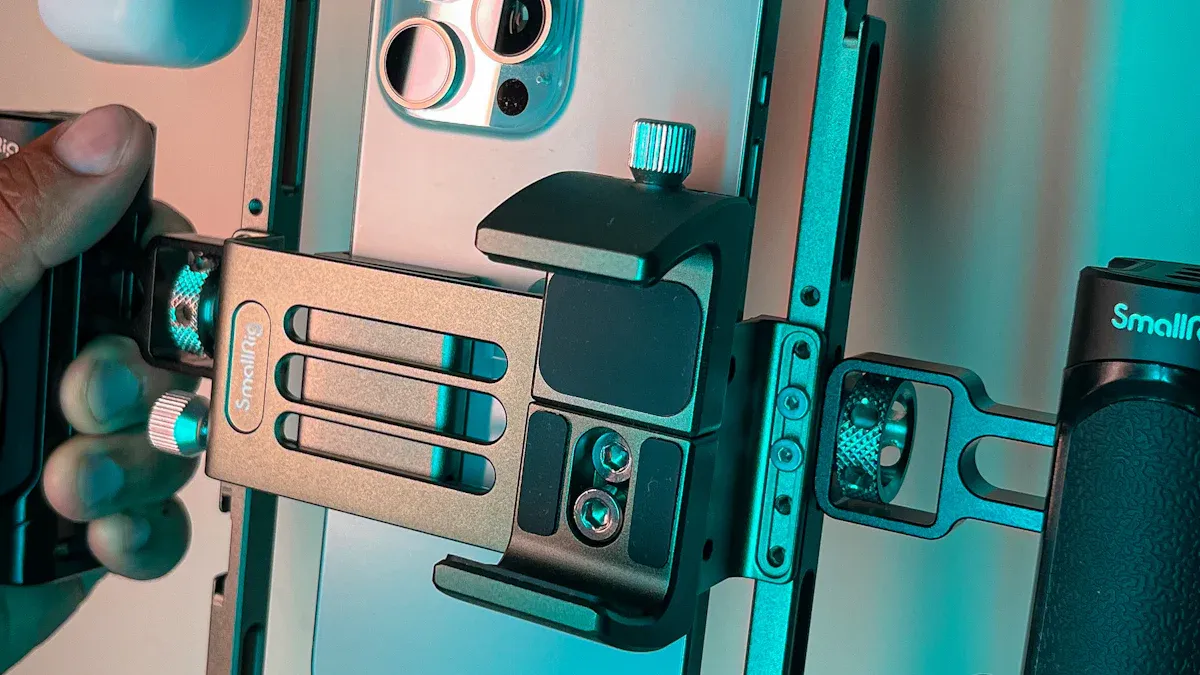How FEP Shrink Tubing Improves Neurosurgical Catheter Efficiency

FEP shrink tubing for neurosurgical catheters revolutionizes how you approach surgical procedures. Its unique properties, such as biocompatibility and chemical resistance, ensure safety and performance in critical medical applications. The tubing acts as a protective layer, enhancing the durability and reliability of medical catheter devices. Its heat shrink capabilities allow precise customization, improving flexibility and offering reliable performance. This innovation not only boosts the protection of catheters but also ensures better outcomes for patients by maintaining the highest standards of safety and performance.
Key Takeaways
FEP shrink tubing makes neurosurgical catheters safer because it is biocompatible. This means it does not cause harmful reactions during surgeries.
FEP tubing resists chemicals, allowing safe fluid transfer. It prevents contamination and works well in tough surgical conditions.
FEP's heat shrink feature makes it flexible and easy to customize. This helps create catheters designed for specific medical needs.
FEP tubing is very clear, making it easy to inspect catheters. This improves quality checks and lowers risks during surgeries.
Using FEP tubing in neurosurgery helps patients recover faster. It also reduces problems during important procedures.
Unique Properties of FEP Heat Shrink Tubing

Biocompatibility
When working with neurosurgical catheters, you need materials that are safe for the human body. FEP, or fluorinated ethylene propylene, stands out due to its exceptional biocompatibility. This property ensures that the tubing does not cause adverse reactions when in contact with sensitive tissues or fluids. Its inert nature minimizes the risk of inflammation or rejection, making it ideal for critical medical applications. By using FEP heat shrink tubing, you can trust that your devices meet the highest safety standards for patient care.
Chemical Resistance
FEP tubing offers unmatched chemical resistance, making it a reliable choice for neurosurgical environments. Its chemically inert and thermally stable properties ensure safe fluid transfer without contamination or leaks. You can confidently use it in procedures involving exposure to aggressive substances like cleaning agents or fuel additives. Additionally, FEP resists degradation when exposed to acids, bases, and hydrocarbons. This durability ensures that the tubing maintains its integrity even in harsh conditions, providing consistent performance during delicate surgeries.
Key advantages of FEP's chemical resistance include:
Safe handling of aggressive chemicals.
Long-lasting performance in demanding environments.
Resistance to almost all commonly encountered solvents.
Heat Shrink Capabilities
The heat shrink capabilities of FEP tubing make it a versatile solution for neurosurgical catheters. Compared to other materials like PTFE or polyolefin, FEP requires a lower shrink temperature, making it easier to apply. Its exceptional clarity allows you to inspect underlying components during and after the shrinking process. This transparency ensures quality control by helping you identify defects or contamination.
Property | FEP Tubing | PTFE Tubing | Polyolefin Tubing |
|---|---|---|---|
Shrink Temperature | Lower than PTFE, easier to apply | Higher, suitable for extreme heat | N/A |
Clarity and Transparency | Exceptional, ideal for inspection | Opaque | Opaque |
Flexibility | Greater flexibility | Less flexible | More rigid |
With FEP heat shrink tubing, you gain precision and reliability, ensuring your devices perform optimally in critical neurosurgical applications.
High Transparency
When working with neurosurgical catheters, you need materials that allow precise monitoring and inspection. FEP offers exceptional transparency, making it an ideal choice for tubing in medical applications. Its high clarity lets you visually inspect the catheter's internal components during manufacturing and after assembly. This feature ensures that you can detect any defects or contamination before the device is used in a surgical procedure.
The transparency of FEP tubing also plays a critical role during surgeries. You can monitor fluid flow and ensure that the catheter is functioning as intended. This real-time visibility reduces the risk of complications and enhances the overall safety of the procedure. Unlike opaque materials, FEP allows you to maintain full control and confidence throughout the process.
Tip: Using transparent tubing like FEP can improve quality control and patient safety by enabling thorough inspections at every stage.
FEP tubing's clarity does not compromise its other properties. It retains its chemical resistance, biocompatibility, and flexibility while providing unmatched visibility. This combination of features makes it a versatile and reliable material for neurosurgical applications. You can rely on FEP tubing to deliver consistent performance without sacrificing transparency.
In addition to its functional benefits, the aesthetic appeal of FEP tubing can also enhance the perception of quality in medical devices. Clear tubing conveys precision and attention to detail, which can instill confidence in both medical professionals and patients. By choosing FEP tubing, you ensure that your devices meet the highest standards of performance and reliability.
Benefits of FEP Shrink Tubing for Neurosurgical Catheters
Enhanced Flexibility
FEP heat shrink tubing offers unmatched flexibility, making it an essential component in neurosurgical catheters. Its pliable nature ensures smooth fluid flow during complex surgical procedures, which is critical for effective treatment delivery. You can rely on this tubing to adapt seamlessly to intricate configurations, allowing easy installation even in the most delicate surgical environments. This flexibility not only enhances usability but also ensures that the tubing maintains its protective layer without compromising its structural integrity.
Note: Flexible tubing reduces the risk of kinks or blockages, ensuring consistent performance during critical procedures.
FEP tubing’s flexibility also contributes to its durability. It withstands repeated bending and manipulation without cracking or losing its protective properties. This makes it a reliable choice for medical catheter applications where precision and adaptability are paramount. By choosing FEP heat shrink tubing, you ensure that your devices deliver consistent safety and performance in demanding surgical settings.
Precision and Customization
FEP heat shrink tubing enables you to achieve unparalleled precision and customization in catheter design. Its versatility supports the creation of specialized devices tailored to specific medical needs. For example:
Reinforced tubing enhances durability for high-stress applications.
Micro-tubing provides precision for delicate surgical procedures.
Heat shrink tubing allows for miniaturization, ideal for advanced guide wires and catheters.
Customization options extend to size, color, and length, ensuring that the tubing meets the exact requirements of your medical catheter designs. This adaptability allows you to create devices that align perfectly with the demands of modern neurosurgical procedures.
Tip: Customizable FEP tubing improves reliability by ensuring that every component fits seamlessly into your device's design.
FEP tubing’s precision also enhances its role as a protective layer. It conforms tightly to underlying components, providing robust protection against external factors while maintaining its transparency and flexibility. This combination of features ensures that your devices perform reliably, even in the most challenging surgical environments.
Real-World Applications of FEP Shrink Tubing in Neurosurgery

Use in Minimally Invasive Procedures
FEP shrink tubing plays a vital role in advancing minimally invasive neurological procedures. Its flexibility and precision make it indispensable for creating microcatheters and guide wires. These tools allow you to access delicate areas of the brain with minimal disruption to surrounding tissues. The tubing ensures smooth fluid transfer, which is critical for delivering medications or removing fluids during surgery.
Peelable heat shrink tubing further enhances safety by enabling the miniaturization of surgical instruments. This feature supports the development of ultra-small devices, such as microcatheters, that are essential for navigating complex neural pathways. You can rely on FEP tubing to maintain its protective layer while adapting to intricate configurations, ensuring consistent performance in these demanding procedures.
Key applications of FEP tubing in minimally invasive surgeries include:
Safe fluid delivery systems.
Miniaturized microcatheters for accessing delicate brain areas.
Peelable tubing for advanced guide wires.
Role in Advanced Imaging Catheters
FEP heat shrink tubing enhances the functionality of advanced imaging catheters by combining biocompatibility, chemical resistance, and optical clarity. These properties ensure that the catheters remain safe for use in medical procedures while maintaining precision in imaging. The tubing’s transparency allows you to inspect the devices for defects, ensuring quality control before use.
The non-stick surface of FEP tubing simplifies cleaning, reducing the risk of cross-contamination. This feature is particularly important in imaging catheters, where maintaining sterility is critical. By using FEP tubing, you can trust that your medical catheter will deliver accurate imaging results while meeting the highest safety standards.
Contribution to Electrode-Integrated Catheters
Electrode-integrated catheters benefit significantly from FEP heat shrink tubing. Its biocompatibility ensures that the tubing is safe for use in medical applications, minimizing the risk of adverse reactions. The chemical resistance of FEP protects the catheter from degradation during procedures, ensuring long-lasting performance.
The optical clarity of FEP tubing allows you to inspect the underlying device for defects, ensuring quality control. This feature reduces contamination risks and enhances the reliability of electrode-integrated catheters. By choosing FEP tubing, you gain a protective layer that supports the functionality and safety of these advanced surgical instruments.
Examples of Successful Outcomes
FEP tubing has already demonstrated its value in numerous neurosurgical applications, leading to remarkable outcomes for patients and surgeons alike. By using this advanced material, you can achieve higher precision and reliability in critical procedures. Below are some real-world examples that highlight the impact of FEP tubing in neurosurgery.
Improved Recovery in Aneurysm Treatment
Surgeons have used FEP tubing to develop microcatheters for treating brain aneurysms. These catheters allow precise delivery of embolic agents to the affected area. The tubing’s flexibility and biocompatibility ensure minimal disruption to surrounding tissues. Patients treated with these devices often experience faster recovery times and fewer complications.Enhanced Imaging for Tumor Resection
Advanced imaging catheters made with FEP tubing have improved the accuracy of tumor resections. The tubing’s transparency allows you to monitor fluid flow and inspect the catheter for defects during surgery. This clarity ensures that imaging devices function optimally, helping surgeons identify and remove tumors with greater precision.Breakthroughs in Deep Brain Stimulation (DBS)
Electrode-integrated catheters, protected by FEP tubing, have revolutionized DBS procedures. These devices deliver electrical impulses to specific brain regions to treat conditions like Parkinson’s disease. The tubing’s chemical resistance and durability ensure long-term performance, giving patients a better quality of life.
Note: These examples show how FEP tubing contributes to safer, more effective neurosurgical procedures. By incorporating this material into your devices, you can achieve similar success in your practice.
FEP tubing continues to set new standards in neurosurgery. Its unique properties enable you to create innovative solutions that improve patient outcomes and advance medical technology.
FEP shrink tubing for neurosurgical catheters represents a breakthrough in medical technology. Its biocompatibility ensures safe fluid transfer without harmful leaching, while its optical clarity allows you to inspect for defects, enhancing quality control. The tubing’s non-stick surface simplifies cleaning, reducing cross-contamination risks. These features make it a cornerstone of safer and more reliable neurosurgical procedures.
By improving flexibility, durability, and precision, FEP tubing enhances the safety and performance of medical devices. Its chemical resistance and adaptability ensure long-term reliability in demanding surgical environments. As neurosurgery evolves, you can rely on FEP shrink tubing to support innovative solutions that improve patient outcomes and advance medical technology.
FAQ
What makes FEP tubing ideal for neurosurgical applications?
FEP tubing offers biocompatibility, chemical resistance, and flexibility. These properties ensure it performs safely and reliably in delicate neurosurgical procedures. Its transparency also allows you to inspect components for defects, enhancing quality control.
How does FEP tubing improve catheter durability?
FEP tubing resists chemical degradation and withstands repeated bending. This durability ensures your catheters maintain their protective layer and structural integrity during demanding surgical procedures.
Can FEP tubing be customized for specific medical needs?
Yes, FEP tubing supports customization in size, length, and design. You can create specialized devices, such as microcatheters or electrode-integrated catheters, tailored to meet the unique demands of neurosurgical procedures.
Is FEP tubing safe for use in the human body?
FEP tubing is highly biocompatible. It minimizes the risk of adverse reactions when in contact with sensitive tissues or fluids, making it a safe choice for neurosurgical applications.
How does FEP tubing enhance minimally invasive surgeries?
FEP tubing’s flexibility and precision allow you to create microcatheters and guide wires for minimally invasive procedures. These tools help you access delicate brain areas with minimal disruption, ensuring safer and more effective surgeries.
See Also
Advantages of Using FEP Heat Shrink Tubing in Medicine
FEP Heat Shrink Tubing Versus Polyolefins for Surgical Instruments
New Developments in FEP Heat Shrink Tubing for Healthcare

